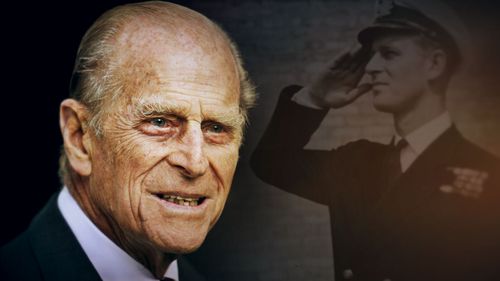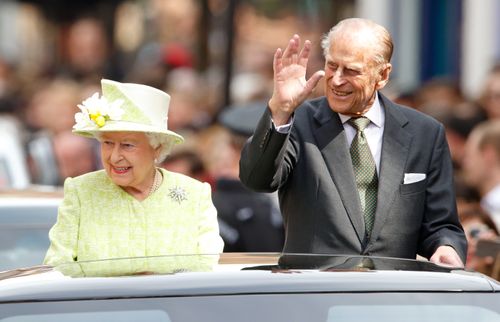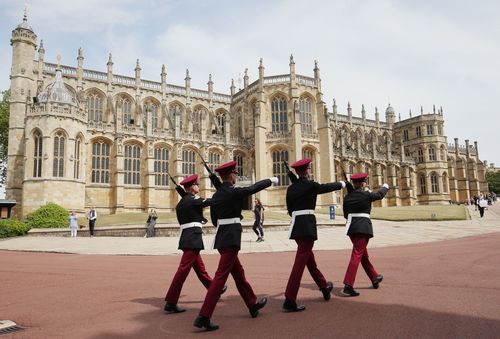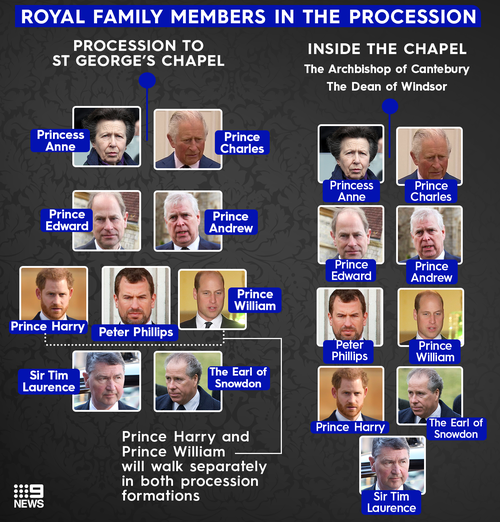The ceremony will take place in St George’s Chapel in the grounds of Windsor Castle and Channel 9 will have special coverage from 11pm AEST.
Many will remember the location as the setting of more jubilant royal moments, like the 2018 weddings of Meghan Markle to Prince Harry and Princess Eugenie to Jack Brooksbank.

But unlike those events, there will be no crowds. Like many other occasions this past year, Philip’s funeral has been heavily adapted because of coronavirus — with all public elements removed.
Of course, his closest family will be there, but the 30-person congregation rule puts a tight limit on who else will attend. Nonetheless, Philip’s other family — his military family — will play an essential part, with around 730 armed forces personnel involved.
While the last-minute changes were necessary to ensure compliance with pandemic measures, the arrangements were meticulously planned over the years, with Philip heavily involved. The plan was signed off by the Queen and reflects the prince’s final wishes, Buckingham Palace has said.

At the Queen’s coronation, Philip vowed “to become your liegeman of life and limb, and of earthly worship; and faith and truth I will bear unto you, to live and die, against all manner of folks.” And through his robust devotion as the longest-serving consort, he did just that.
He never wanted a state funeral — usually reserved for monarchs — and made that clear to the Lord Chamberlain’s Office, which has organised the event. It will, instead, be a level below — a royal ceremonial — as was granted to the Queen Mother in 2002 and Diana, Princess of Wales in 1997. But it will still be a remembrance steeped in tradition and symbolism, from the moment the coffin leaves the state entrance of Windsor Castle and is processed through the grounds to St George’s.
Philip’s coffin has been lying in the private chapel at Windsor Castle. On Saturday morning (UK time), it will be moved to the Inner Hall, where the Dean of Windsor will say a prayer over it before the day’s events begin.
At 11.41pm (AEST), the coffin — covered by the duke’s personal standard — will be brought by bearers from The Queen’s Company, 1st Battalion Grenadier Guards to the state entrance. His sword and naval cap will be placed on top, along with a wreath of flowers.
At 11.45pm (AEST), the procession will leave the quadrangle, led by the Band of the Grenadier Guards regiment — of which Philip was colonel for 42 years.

The coffin will be carried the short distance to the chapel on a modified Land Rover — which Philip helped design — and flanked by pall bearers highlighting his relationships with the Royal Marines, Regiments, Corps and Air Stations. Philip, a war hero decorated for his service in World War II, gave up a flourishing naval career to dedicate himself to his royal duties.
Military rehearsals for those involved in the ceremonial procession were held in Pirbright, an army training centre southwest of London, all week. A separate full- dress rehearsal — which includes all service bands and the full funeral parade — took place at Windsor Castle on Thursday.
Prince Charles and other members of the royal family will trail the Land Rover on foot, while staff from Philip’s household bring up the rear. William and Harry will walk in the same row, but separated by first cousin Peter Philips. The brothers would usually walk shoulder to shoulder, but Buckingham Palace would not be drawn on how family tensions were being dissipated.
The Queen, accompanied by a lady-in-waiting, will travel to the chapel in a state Bentley.
Family members who are not involved in the procession, such as the Duchess of Cornwall and Duchess of Cambridge, will join the 94-year-old monarch to watch the funeral parade outside the chapel’s Galilee porch. This also includes the Duke’s German relatives who will be in attendance, including his great nephews, the Hereditary Prince of Baden and the Prince of Hohenlohe-Langenburg.
In a break with tradition, royals in the procession will not wear military uniform and will instead wear morning coats with medals or day dress.
Clothing has become a hot topic in recent days, after reports emerged that Prince Andrew, who stepped back from royal work two years ago, was considering wearing an admiral’s uniform.
The decision to forgo military dress will also save Prince Harry embarrassment, since he was stripped of his honorary military titles last March after stepping back as a senior royal.

At 11.53pm (AEST), the procession will come to an end at the foot of the West Steps of St. George’s Chapel.
At midnight (AEST), a national minute of silence will be held before the coffin continues up the steps and is met by the Dean of Windsor and the Archbishop of Canterbury at the top. The archbishop will lead the service. Due to the COVID congregation limits, only the family members involved in the funeral parade will enter the chapel after the coffin.
In keeping with public health rules, the congregation will wear masks during the 50-minute service.
A four-person choir — seated away from mourners in the nave — will sing a selection of music picked by the duke.
The Dean will give the commendation as the coffin is lowered into the Royal Vault, where many members of the royal family have been laid to rest. The vault, set beneath the chapel, was built by George III, who is one of several kings buried within.
However, it will not be Philip’s final resting place. When the Queen dies, he will be reunited with his wife of 73 years and transferred to the King George VI memorial chapel (another part of the gothic church) to lie next to her. Buried in the vault already are the Queen’s father, her mother Elizabeth and sister Margaret.
Windsor Castle has seen a lot of history and today will be no different.
Philip was at times a controversial figure, but the legacy that will be celebrated today is his passion for innovation, from his drive to allow cameras into the royal household to show the family does normal things such as host barbecues, to his determination to launch an official family website to disseminate its work to the wider world, to founding the Duke of Edinburgh award scheme to inspire young people to realise their potential.
When he became consort, he didn’t have a defined role, so he defined it himself. He used his profile to champion issues he cared about. His place in British history is assured for what he did rather than who he was. He will be remembered as a man who not only supported, but also advised, one of the most successful monarchs in British history.
9News.com.au will have extensive coverage across the website.
Follow our live blog for every moment out of the UK.
This content first appear on 9news

